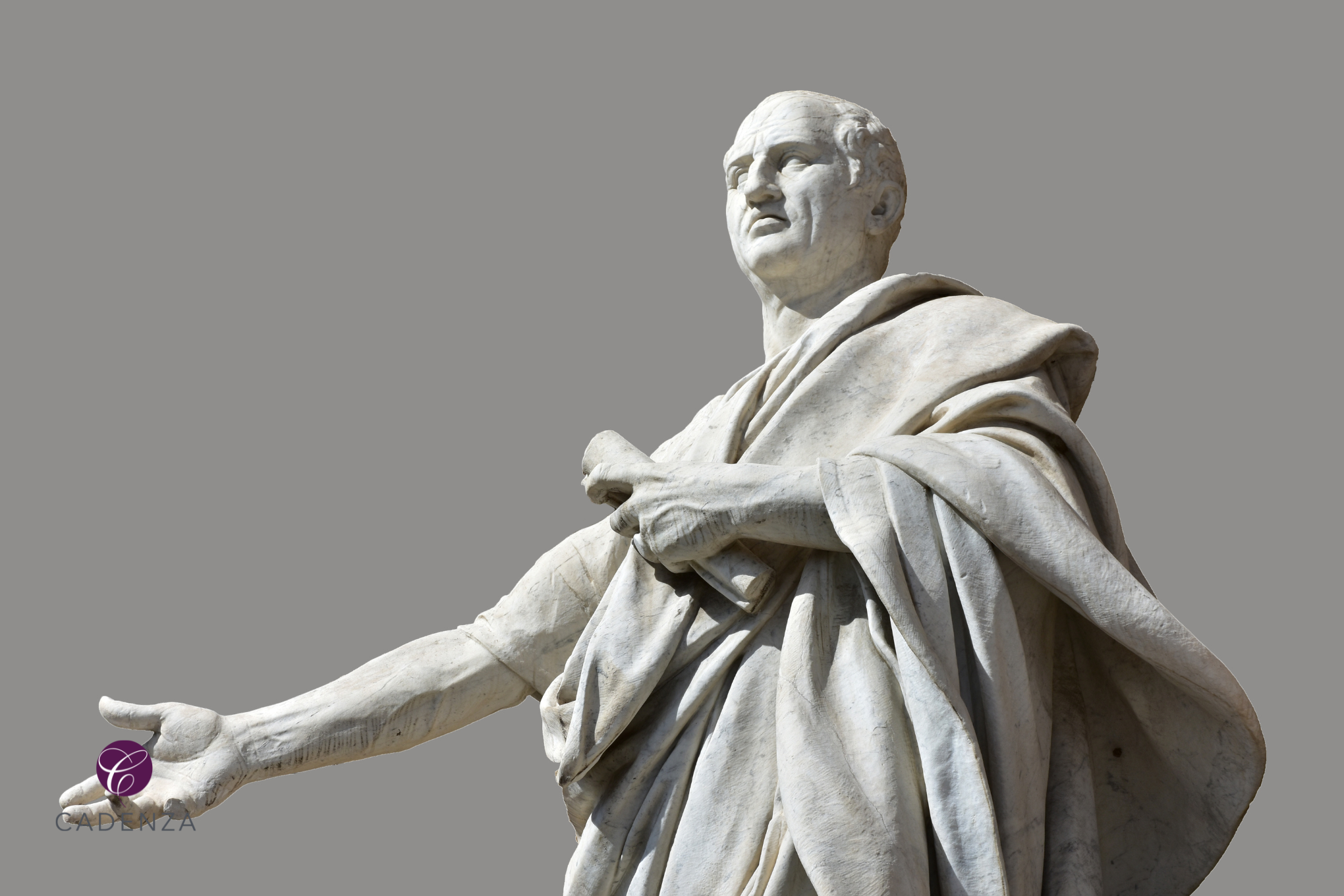CEO Communication
How Powerful Ancient Romans Spoke
The 5 Canons of Rhetoric
The 5 Canons of Rhetoric are the timeless Public Speaking system followed in the Roman Empire that will transform your stage presence.

Mastery of an impeccable and authentic communication style that showcases your skills, expertise and value is the aspiration of many business owners and ambitious career-driven professionals. Fortunately, the historical account means we don’t need to stumble in the dark because, alongside recent research into what creates persuasive communication, we can also look to history’s greatest minds who also consumed themselves with the topic of influence.
A discussion of persuasive communication prowess would be incomplete without first considering the significant impact of the ideas of Marcus Tullius Cicero, ancient Rome’s most outstanding public speaker.
In this article, you’ll learn how Cicero’s 5 Canons of Rhetoric can transform your insight into persuasive communication with some practical strategies that will make you wonder why, among other things, you didn’t hear about this at school.
This blog post is best digested in 3 parts:
- Check the tips summarised below.
- Watch the vlog for more detailed training.
- Learn more about our elite communication training program for CEOs, Founders and Industry disruptors, which provides detailed strategies on building up elite presenting skills.
Since the early eons of time, humans have sought to influence the people around them with intelligent, smooth and powerful communication.
Rhetoric, or the art of verbal persuasion, was first coined in the 5th Century BC, which sparked a model for presenting ideas in public.
Some 45 years later, Cicero refined rhetoric’s early roots, writing a premier handbook for public speakers in his late teens, De Inventione, the first of many works where he sought to encapsulate the components of eloquent public speaking and oration.
The 5 Canons of Rhetoric provide an often-forgotten system for eloquent and persuasive public speaking. Devised by Cicero, they can assist us in understanding key components of persuasive communication. You can apply their tents to both written and spoken communication. Better still, the canons of rhetoric provide a solid foundation in how to build persuasive messages.
Canon 1: Invention
The first persuasive skill that starts off the 5 canons of rhetoric relates directly to how you plan and structure the content of your message. Stemming from the Latin word, inventio, this canon describes the process by which you systematically prepare your “argument” or the crux of your discussion points.
How to know if you need to work on invention skills to be more persuasive
If you’re an aspiring public speaker who finds it incredibly effortful to develop a solid plan about what to present and which topics to explore, strategic tools that assist you to extract new ideas and perspectives to share with your audience will significantly benefit your speaking preparation. Likewise, if you notice it is difficult to generate ideas when put on the spot in team meetings or while answering unexpected questions, you may have some communication growth opportunities relating to verbal reasoning skills, concept development and idea expansion.
Cicero considered that the first step to a persuasive speech or message is a solid well, thought out foundation grounded in one or more of the following:
#1: A discussion of facts
In presenting a persuasive message, you can provide facts, proof and data to create compelling insights and establish yourself as an authority on the topic.
To develop a persuasive message, consider what concrete facts, proof, data, or research is relevant to your discussion that might enlighten and add value to the topic.
An example of this would be a public speaker using findings from their research to justify their argument, a CFO reporting on company growth by displaying financial reports in an AGM, or a doctor confirming you’re not anemic by showing you your recent blood test results.
It can be hard to present dry numbers, complex data sets, or rigid financials in an accessible manner, but be reassured that there is a charismatic way to do it. Our elite communication services will add incredible value and impact how you present and prepare your high-pressure speaking activities to keep your listener engaged, the first step to gaining trust in your expertise.
At Cadenza, our services assist you in presenting facts precisely and concisely using an engaging voice tone to deliver the information with increased credibility and keep your audience interested.

#2: Definitions of new or important concepts
If you’re working with contacts and stakeholders who don’t have the same skill set as you, you’ll know how challenging it is to listen to jargon and insider language. Persuasive messages must be both understandable and relevant to the audience. One way to ensure that your audience finds your insights relevant is to consider what concepts must be defined. Not only will you clarify the topic, but you will also show consideration to your unique audience.
An example of this would be an academic defining a key term used in their research in a radio interview so the general public can understand the impact of their study or a CFO explaining a type of financial measure at an AGM before showing their company’s performance over the past quarter, or a doctor explaining what anemia is before outlining what you need to do to address it.
It can be hard to identify precisely how much background information is needed to give value to your listener because audiences can vary drastically in their knowledge and sophistication regarding your topic.
Pitching your discussion to the right knowledge level takes careful consideration. The best practice is to work on your ability to use plain language, metaphors or captivating storytelling to make advanced concepts easily accessible and memorable.
Safeguard yourself from sounding too high-brow with non-experts- you’ll lose rapport and seem pretentious or self-inflated. Also, don’t oversimplify your ideas for expert listeners- you’ll appear condescending. The amount of information you provide can be a hookpoint or breakpoint for rapport.
Your challenge is crafting your message in a way that appeals to a mixed audience of experts and non-experts, something that elite orators strategically plan so that a large room of diverse minds can feel included and addressed regardless of their expertise level.
At Cadenza, our elite communication services will add incredible value and impact how you present and prepare your message to position it in a way that gains appeal by providing the right degree of background information and detail so that your contacts find relevance in what is said. We can assist a project leader in a large meeting full of mixed disciplines to refine key messages so that diverse stakeholders can gain value from a meeting and build team mutuality, a CEO to deliver change management conversations that define the minimum amount of information needed when introducing drastic change to increase ease of adoption among their employees or even help a top-level physicist explain their advanced complex research ready for a media presentation or Ted Talk. Whatever it is, consider that the quantity and balance of information in your presentation are just as critical as what is said if you want to gain a persuasive impact.

#3: Questions of Quality
Persuasive messages appeal to human emotions. A surefire way to add human interest is to embed your presentation with purposeful attempts to share your ethical standpoint or align your perspective with a set of values. You can interrogate your argument and presentation and lift its chance of listener engagement by considering what values, ethics, and motives your viewpoints emphasize. Step aside and critically evaluate your presentation topic.
Does it endorse admirable values? Are there any noteworthy value judgements you want to share?
Are your conclusions well-founded?
What biases, assumptions or judgements reduce the credibility of your proposals? Presentations that showcase mutual benefit and a human element are more likely to catch attention.
Likewise, considering objections to your topic and having the tools to explain your reasoning in the face of opposition will give you a powerful bargaining chip if you need to negotiate your way to influence.
An example of incorporating questions of quality would be a researcher debunking myths and pseudoscience claims against their study’s results, a CFO predicting financial risk on the basis of financial data or a doctor outlining the importance of an iron rich diet and its impact on physical energy levels when encouraging treatment compliance for an anemic patient.
Taking a clear position is a vital element of credibility and authentic communication. If you neglect the social nature of information sharing, you may miss out on influence. Since it is impossible to surround ourselves with “yes men”, there comes a point where how you share your perspectives will determine how much influence you can gain. Executive Communication Services at Cadenza will assist you in presenting your ideas with conviction, even to listeners who are diametrically opposed to you, so that you can find common ground in a rapport-building, influential way, even when shared interest is hard to find.
#4: Which communication channel best suits your message?
In ancient times, orators planned their speeches to fit the exact jurisdiction they were speaking in.
Whether you’re an industry leader building your brand, a CEO seeking influence or a business owner trying to capture market attention, consider what messages you share and where.
Just as a presenter in a traditional public speaking space needs to consider the context, location and audience they will speak for, where your message is shared can be just as important as what is shared.
Unlike Cicero in 45 BC going before the courts, A CEO building their brand might consider which social media platforms best fit their ideas and profile and how to modify their message to suit each platform. Similarly, a change manager in a large organisation may plan the change management process by choosing the most appropriate communication channel for large-scale change (selecting from large company gatherings, one-to-one sessions, email memos, and more).
Frequently, companies lose influence after poor handling of their jurisdiction when sharing critical information. You might recall Solera’s choice to announce mass staff layoffs over a large Zoom meeting and other such scenarios. While mass layoffs are never lovely news, the furore could have been reduced had the organisation better handled the system and context where they delivered the news.
Remember, every persuasive message pivots around a solid argument or premise. Developing solid arguments is a trainable skill that involves structured thinking. At Cadenza, we assist you to fast track your ability to refine information so that you can reason with increased precision and garner influence when presenting.
Optimise your Voice Tone, Boost Your Speaking & Express yourself Clearly.
A lot can be said for how to streamline your speaking skills as a CEO, Leader or Founder to guarantee fast and agile communication responses.
At Cadenza, we assist CEOs in optimising their already solid management communication skills to synchronise tactical messages if sleep-deprived, time-poor or work load burdened.
Learn more about our elite communication training program for CEOs, Founders and Industry disruptors.
Canon 2 Arrangement:
Cicero’s second canon asserts that a logical structure must embed all persuasive messages.
This theory rings true, especially with mounting evidence from recent research into the importance of language structure skills to charisma, credibility and trustworthiness.
Verbal expression skills in Cicero’s time were highly regarded, with orators relying on more detailed structure tools than our stock stand: intro, body, and conclusion. Cicero and his contemporaries used to rely on a five-stage set of steps to structure a persuasive speech. The classical speech structure involved an introduction, a statement of objective facts, a positioning of the argument, rebuttals of possible objections and a conclusion. This model is still valid today, but the benefit of history and extensive research in corporate communication science opens up a plethora of structure tools you can use to present persuasive ideas, rapport-building conversations, assertive positions and more.
How you arrange your message will significantly determine how much buy-in you elicit from your listeners.
“Well-planned and structured explanations result in greater understanding and better retention of the verbal content, and thus in more successful interpersonal transactions” (c.ref Hargie and Dickson, 2004).
At Cadenza, we train you to build up your command of logical flow to quickly assimilate large amounts of information into the precise and concise statements that give persuasive communicators expansive success.

Canon 3 Elocution/Style:
Once you’ve determined what to say and in what order to present it, the next consideration is the third canon- how you say it. Stemming from the Latin word elocutio (style), this canon opens up incredible scope for persuasive hook points when you present.
When we consider this canon, we consider the words we use, the rhythm of our speaking, and the distinct style by which we add flair and flavour to expressing our perspectives.
Cicero was very generous in his discussion of elocution, building a framework for an entire discipline and even service that still exists today.
There is so much to be said for elocution from the words of Cicero, such that we will raincheck this goldmine of ideas for you for another day, but for now, consider your communication style can shape or totally sabotage your ability to lead your team, gain influence and build up a solid public profile.
To develop into a growth leader, your communication needs to be exceptional. Over on our blog, we have extensive tips that can assist you in understanding more about the style of speaking that builds trust, charisma, and rapport. Here are a few articles you can check to learn more:
- How Elocution Lessons Unlock the Next Level in Speaking Confidence at Work
- 5 Communication Activities CEOs can Use to Influence Organisational Behaviour
- How to Stop Mumbling & Sound More Influential at Work
- How to Secure a Crystal Clear Voice Tone that Never Fails You (Even When You’re Nervous)
- The Undercover Toolkit of a Charismatic Leader that Takes Them to The Top
You might also like to attend my on-demand Speaking Masterclass.
Free Masterclass
How to Look, Sound & Feel Confident at Work
If you’re curious to learn more and enhance your professional presence, I’d like to cordially invite you to a free Masterclass – How to Look, Sound and Feel Confident at Work.
THIS CLASS IS A PRIORITY-WATCH IF…
✅ You feel like your personality sometimes holds you back from speaking confidently at work
✅ You don’t know exactly what your communication at work needs, but you know it needs to change fast.
✅ You can’t pin what it is that prevents you from securing a promotion or leadership opportunity and need to increase your executive presence.
✅ Your voice tone doesn’t work for you reliably, leaving you sounding hesitant and nervous when under pressure.
✅ You admire charismatic communicators and wish you could engage and inspire the way they do.
✅ Difficult conversations at work shake your confidence and you want some strategies to control your responses with polish.
Canon 4 Memory:
In the classical era, audiences were blessed because there was no power point to bore them. Orators had no flashcards or tablets to rely on and often spoke for long hours (Jesus’ Sermon on the Mount is thought to have taken several days, following the tradition of Aristotle, Plato and Socrates). Fidel Castro would have fit in so well in Ancient Rome.
Adroit memory was a given, and esteemed orators were known for their ability to speak on a topic without a thought glitch.
Perhaps we are losing the ancient art of telling stories now that oral history has lost it’s necessity. With demeaning attention spans, most humans struggle to retain information, let alone produce long ideas sequences across extensive durations.
But all is not lost, because we can still learn from Cicero and contemporaries. While reciting your presentation verbatim and from memory is not ideal (it will drop authenticity), there are tools that will give you mental clarity and recall for high volume messages.
Memorised speeches are seldom persuasive unless rendered so by an expert actor or performer. Likewise you can’t rely on a teleprompter and if you have one handy, that in itself takes skill and practice to both look and sound natural.
How can we then position our message in front of an audience with an organic melody and all the points in recall?
Performance anxiety management tools, theatre level rehearsal, media appearance training and presentation simulation sessions are all available at Cadenza in our executive communication program so that you can speak with utmost composure and engaging expression while still remembering all that you intended to share.

Canon 5 Delivery:
What you say and how you look while saying it relies on flawless delivery.
Cicero’s final canon considers public speaking as a necessary theatrical act.
When you deliver a presentation, keynote or Ted Talk, your audience becomes involved in a sensory experience. What you wear and how you sound and move will all shape the degree to which the crowd finds you believable and influential.
Delivering a polished presentation requires professional performance skills. So if you’re a business leader, founder or executive, and you never went to theatre school, what can you do to cinch a successful, especially if you notice your nerves spill onto the stage and show up with
- Jerky awkward movements
- Poor posture
- Anxious facial expressions
- Hesitant voice tone
- Rapid speaking rate
- Feelings of breathlessness
- And more?
Firstly, you should check this PEP talk, which will give you CPR for your public speaking anxiety.
Secondly, consider that improving your public speaking presentation style starts with concrete tactics, behaviour change and expert feedback, not mindset or breathwork!
There is a concrete process to get better at public speaking and to look self-assured and confident on camera, and it all starts with gaining presentation literacy through verified communication performance techniques.
🔗 Related blog post: Public Speaking CPR
Although an Ancient Roman framework for public speaking, Cicero’s 5 Canons of Rhetoric principles are highly relevant to anyone wanting to improve their stage presence. These canons provide a transparent system behind what triggers persuasive communication so that you can more confidently position your ideas to gain conviction and influence with your contacts.
Humans that speak well under pressure solve problems better under pressure.
- Enhance your leadership communication skills, reputation management and presentation skills
- Develop your team’s communication abilities
Want to learn more?
References
- Cicero, M. (2016) How to Win an Argument: An Ancient Guide to the Art of Persuasion (May, J, Ed.) Princeton University Press.
Did you enjoy this post? Make sure to subscribe to our YouTube channel to get more content to increase your communication skills!
About the Author
Dr Sarah Lobegeiger de Rodriguez is a Keynote Speaker, Executive Speaking Coach, and Opera Singer who likes to play with words, sounds, and your impact.
Her academic background is in Music Performance, Communication Science and Speech & Language Pathology. She assists executive communication clients all over the world as a communication consultant with strong expertise in CEO, Founder and Entrepreneur communication strategies.
Connect with Sarah on LinkedIn.







